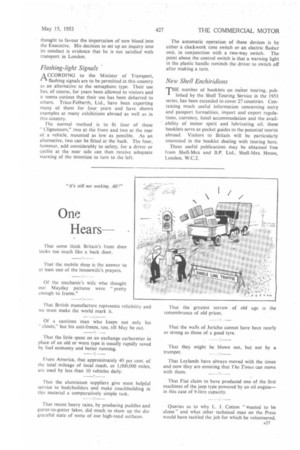Passing Comments
Page 28

Page 29

If you've noticed an error in this article please click here to report it so we can fix it.
Fillip for Battery-electrics
PXEMPTION of battery-electric vehicles from purchase tax will give a fillip to manufacturers of these machines which is especially timely, as their output has fallen 64 per cent. since 1949, whilst the number of skilled workers they employ has dropped by 22 per cent.
Austin Crompton Parkinson Ltd., claim that the running costs of battery-elect rics are now approximately £111 less per annum than for petrol vehicles.. Weekly running costs of a 10-cwt. battery-electric at £3 18s. 3d. compare with £6 Is. 6d. for a petrol model of equal capacity. For a 1-ton battery-electric, the costs are said to be £5 2s. 4d., and for an equivalent petrol vehicle, £7 18s. 10d.
A Successful Lightweight
DURING the discussion on the interesting paper by Mr. W. G. Copestake, A.M.I.Mech.E., concerning the development of lightweight buses, Mr. W. Wroth, general manager of the Potteries Motor Traction Co., Ltd., referred to the lightweight body built by Metropolitan-Cammell-Weymann, Ltd., and exhibited on their stand at the Commercial Motor Show of 1952. He added that with the Daimler on which this was mounted, he was obtaining a benefit in fuel consumption representing 1.4 m.p.g.
It may not be known by some operators that the principles governing the design of this lightweight double-deck body were evolved by the bodybuilder concerned, before the last war, in fact, five of this type were supplied to Coventry Corporation. They included the " all-up" specification of that munici n26 pality, providing seating accommodation for 60, and the weight of each body was 2 tons 8 cwt. They have given excellent service and one of them has been granted a Ministry of Transport certificate for a further five years' service.
This bus, No. 246, was put on the road on January 18, 1940, and up to the end of last month had covered about 470,000 miles. By the time the new certificate expires, the mileage should be at least 600,000. This says much for both the type of body and the chassis.
Who Will Hold the Keys?
THERE is keen speculation in political circles on the appointments to be made by the Minister of Transport to several vital-posts in transport. One of them is, of course, the chairmanship of the. Road Haulage Disposals Board. The secret has been well kept, and even those in close touch with the Ministry profess to have no idea who has been selected.
A successor to Lord Hurcomb as chairman of the British Transport Commission is also being discussed. The name of Sir Miles Thomas, chairman of B.O.A.C., has been mentioned in this connection. It is believed that he wishes to see the Comet aircraft fully introduced before relinquishing control, but it is thought that when that task is completed he might not be averse to the chairmanship of the B.T.C.
It is believed that when Lord Latham retires from the chairmanship of the London Transport Executive, in September, the Ministry of Transport may appoint a new chairman from outside the industry. Mr. A. B. B. Valentine is regarded as an extremely capable potential successor, but the Minister is thought to favour the importation of new blood into the Executive. His decision to set up an inquiry into its conduct is evidence that he is not satisfied with transport in London.
Flashing-light Signals
CCORDING to the Minister of Transport, I-1 flashing signals are to be permitted in this country as an alternative to the semaphore type. Their use has, of course, for years been allowed to visitors and it seems curious that their use has been debarred to others. Trico-Folberth, Ltd., have been exporting many of them for four years and have shown examples at many exhibitions abroad as well as in this country.
The normal method . is to fit four of these Clignoteurs," two at the front and two at the rear of a vehicle, mounted as low as possible. As an alternative, two can be fitted at the back. The four, however, add considerably to safety, for a driver or cyclist at the near side can then receive adequate warning of the intention to turn to the left. The automatic operation of these devices is by either a clockwork time switch or an electric flasher unit, in conjunction with a two-way switch. The point about the control switch is that a warning light in the plastic handle reminds the driver to switch off after making a turn.
New Shell Enchiridions
THE number of booklets on mo.tor touring, pub' fished by the Shell Touring Service in the 1953 series, has been extended to cover 27 countries. Containing much useful information concerning entry and passport formalities, import and export regulations, currency, hotel accommodation and the availability of motor spirit and lubricating oil, these booklets serve as pocket guides to the potential tourist abroad. Visitors to Britain will be particularly interested in the booklet dealing with touring here.
These useful publications may be obtained free from Shell-Mex and B.P. Ltd., Shell-Mex House, London, W.C.2.




























































































